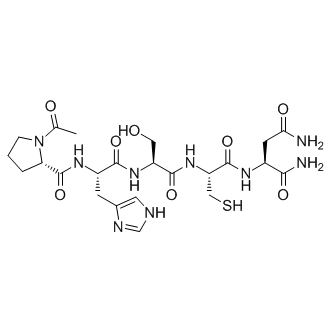| Cas No.: | 262438-43-7 |
| Chemical Name: | ATN-161 free base |
| Synonyms: | ATN161; ATN 161 |
| SMILES: | O=C(N)C[C@@H](C(N)=O)NC([C@H](CS)NC([C@H](CO)NC([C@H](CC1=CNC=N1)NC([C@H]2N(C(C)=O)CCC2)=O)=O)=O)=O |
| Formula: | C23H35N9O8S |
| M.Wt: | 597.64 |
| Purity: | >98% |
| Sotrage: | 2 years -20°C Powder, 2 weeks 4°C in DMSO, 6 months -80°C in DMSO |
| Description: | ATN-161 (Ac-PHSCN-NH2) is a five -amino-acid peptide derived from the synergy region of fibronectin; a beta integrin antagonist with antitumor activity. IC50 value: Target: Integrin antagonist in vitro: ATN-161 inhibited VEGF-induced migration and capillary tube formation in hCECs, but did not inhibit proliferation . in vivo: Murine colon cancer cells (CT26) were injected into spleens of BALB/c mice to produce liver metastases. Four days thereafter, mice were given either ATN-161 (100 mg/kg, every 3rd day) or saline by intraperitoneal injection, with or without combination of continuous-infusion 5-FU (100 mg/kg/2 weeks), which was started on day 7. On day 20 after tumor cell inoculation, mice were killed and liver weights and number of liver metastases were determined . ATN-161 after laser photocoagulation inhibited CNV leakage and neovascularization to an extent similar to AF564. Furthermore, SD-OCT and histologic examinations indicated that ATN-161 significantly decreased the size of laser-induced lesions . Treatment with ATN-161 significantly blunts atherosclerotic plaque development in apolipoprotein E-deficient mice, characterized by reduced vascular cell adhesion molecule-1 expression and macrophage accumulation without affecting fibrous cap size. For the detailed information about the solubility of ATN-161 in water, the solubility of ATN-161 in DMSO, the solubility of ATN-161 in PBS buffer, the animal experiment of ATN-161 ,the in vivo and in vitro test of ATN-161 ,the cell experiment of ATN-161 ,the IC50 and EC50 of ATN-161 please contact DC Chemicals. |

 To enhance service speed and avoid tariff delays, we've opened a US warehouse. All US orders ship directly from our US facility.
To enhance service speed and avoid tariff delays, we've opened a US warehouse. All US orders ship directly from our US facility.




















